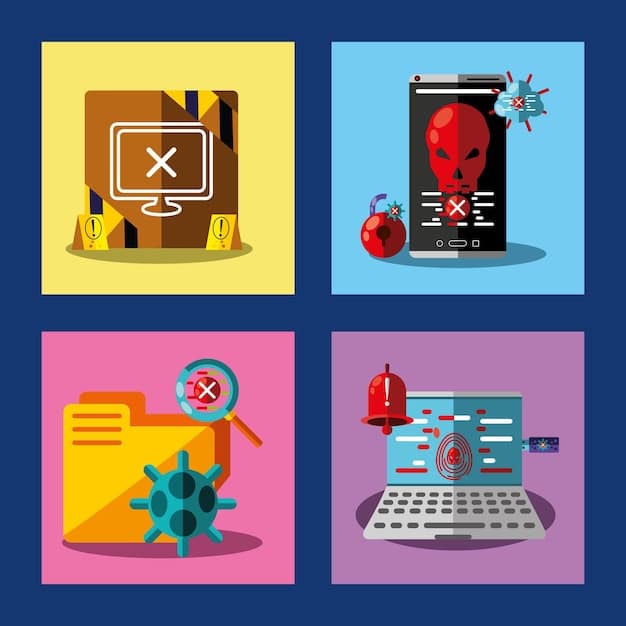Secure Coding Practices: A Cybersecurity Guide to Preventing Vulnerabilities

Secure coding practices are essential for preventing vulnerabilities in software development by implementing techniques such as input validation, secure authentication, and regular security testing to protect against cyber threats.
In today’s digital landscape, software vulnerabilities pose significant cybersecurity risks. Implementing secure coding practices is crucial for preventing these vulnerabilities during software development, safeguarding systems and data from potential breaches.
Understanding the Importance of Secure Coding
Secure coding goes beyond simply writing functional code; it involves developing software with security as a primary consideration. This proactive approach helps mitigate potential risks and vulnerabilities that could be exploited by attackers.
Why Secure Coding Matters
Secure coding practices are the foundation of robust cybersecurity. They ensure that applications are built to withstand attacks and protect sensitive information.
Ignoring secure coding can lead to devastating consequences, including data breaches, financial losses, and reputational damage.
- Reduced Risk: Secure code minimizes the attack surface, making it harder for hackers to find and exploit vulnerabilities.
- Cost Savings: Addressing vulnerabilities early in the development process is significantly cheaper than fixing them post-deployment.
- Enhanced Trust: Secure applications build trust with users, fostering loyalty and positive brand perception.
Ultimately, secure coding is an investment in the long-term security and success of any software project.

Key Principles of Secure Coding
Several fundamental principles underpin effective secure coding. Adhering to these principles helps developers create more resilient and secure applications.
Input Validation
Always validate user input to prevent injection attacks and other input-related vulnerabilities. This includes checking data types, lengths, and formats.
Implement proper encoding and sanitization techniques to neutralize potentially harmful characters and prevent them from being interpreted as executable code.
Authentication and Authorization
Ensure strong authentication mechanisms are in place to verify user identities. Use multi-factor authentication (MFA) whenever possible.
Implement robust authorization controls to restrict access to sensitive resources based on user roles and permissions.
- Least Privilege: Grant users only the minimum necessary privileges required to perform their tasks.
- Role-Based Access Control (RBAC): Assign permissions based on user roles, simplifying access management and reducing the risk of unauthorized access.
- Regular Audits: Conduct regular audits of access control policies to identify and address any potential vulnerabilities.
By adhering to these key principles, developers can significantly improve the security posture of their applications.
Common Software Vulnerabilities
Understanding common software vulnerabilities is crucial for implementing effective secure coding practices. Recognizing these potential pitfalls allows developers to proactively address them.
SQL Injection
SQL injection occurs when an attacker injects malicious SQL code into an application’s database queries. This can lead to unauthorized access, data modification, or even complete database takeover.
Cross-Site Scripting (XSS)
XSS vulnerabilities allow attackers to inject malicious scripts into websites viewed by other users. This can result in session hijacking, defacement, or redirection to malicious sites.
Buffer Overflow
Buffer overflows occur when a program writes data beyond the allocated memory buffer. This can overwrite adjacent memory regions, leading to crashes, code execution, or privilege escalation.

Best Practices for Secure Coding
Implementing best practices for secure coding involves adopting specific techniques and tools to enhance the security of software development processes.
Use Static Analysis Tools
Static analysis tools automatically analyze source code for potential vulnerabilities without executing the program. These tools can identify a wide range of issues, including buffer overflows, SQL injection flaws, and XSS vulnerabilities.
Integrate static analysis tools into the development pipeline to catch vulnerabilities early and prevent them from making their way into production code.
Conduct Regular Security Testing
Regular security testing is essential for identifying vulnerabilities that may have been missed during development. This includes penetration testing, vulnerability scanning, and code reviews.
Involve security experts in the testing process to leverage their expertise and ensure comprehensive coverage.
- Penetration Testing: Simulate real-world attacks to identify weaknesses in the application’s security defenses.
- Vulnerability Scanning: Use automated tools to scan for known vulnerabilities in the application’s components and dependencies.
- Code Reviews: Conduct thorough code reviews to identify potential security flaws and ensure adherence to secure coding standards.
By implementing these best practices, organizations can significantly reduce the risk of software vulnerabilities and enhance their overall security posture.
Secure Coding in Different Programming Languages
Secure coding practices can vary depending on the programming language being used. Understanding the specific security considerations for each language is crucial for developing secure applications.
Java
Java is a popular language for enterprise applications. Secure coding practices in Java include avoiding serialization vulnerabilities, using secure random number generators, and implementing proper exception handling.
Python
Python is widely used for web development and scripting. Secure coding practices in Python include input validation, output encoding, and avoiding eval() function, which can execute arbitrary code.
C/C++
C and C++ are powerful languages but require careful memory management to prevent buffer overflows and other memory-related vulnerabilities. Use secure coding practices like bounds checking and avoiding unsafe functions.
The Future of Secure Coding
As technology evolves, so too will the landscape of secure coding. Staying ahead of emerging threats and adopting innovative security practices is essential for maintaining robust cybersecurity.
Automation and AI
Automation and artificial intelligence (AI) are playing an increasingly important role in secure coding. AI-powered tools can automatically identify vulnerabilities, generate secure code, and even predict potential security threats.
DevSecOps
DevSecOps integrates security into every stage of the software development lifecycle, from design to deployment. This approach fosters a culture of security and ensures that security considerations are addressed proactively.
- Continuous Integration/Continuous Deployment (CI/CD): Automate the build, test, and deployment processes to ensure consistent security practices.
- Security as Code: Define security policies and controls as code, allowing them to be easily managed and enforced.
- Collaboration: Foster collaboration between development, security, and operations teams to ensure a shared understanding of security risks and responsibilities.
The future of secure coding will be driven by innovation, automation, and a holistic approach to security throughout the software development lifecycle.
| Key Point | Brief Description |
|---|---|
| 🛡️ Input Validation | Ensuring all user inputs are validated to prevent injection attacks. |
| 🔑 Authentication | Implementing secure authentication mechanisms to verify user identity. |
| 🧪 Security Testing | Regularly testing software for vulnerabilities using various methods. |
| 🤖 Static Analysis | Using tools to analyze code for vulnerabilities without executing the program. |
Frequently Asked Questions
▼
Secure coding practices involve developing software with security as a primary consideration, including techniques like input validation and secure authentication.
▼
Secure coding is important because it helps prevent vulnerabilities that can be exploited by attackers, protecting sensitive data and systems from breaches.
▼
Common software vulnerabilities include SQL injection, cross-site scripting (XSS), and buffer overflows, all of which can compromise application security.
▼
Static analysis tools automatically analyze source code for potential vulnerabilities without executing the program, helping to identify and address security flaws early.
▼
DevSecOps integrates security into every stage of the software development lifecycle, fostering a culture of security and ensuring proactive consideration of security risks.
Conclusion
Implementing secure coding practices is essential for building robust and resilient software applications. By understanding the principles, vulnerabilities, and best practices outlined in this guide, developers can create secure software that protects against cyber threats and safeguards sensitive information.





